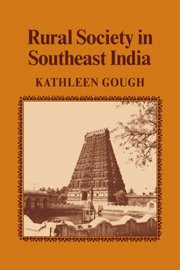Book contents
- Frontmatter
- Contents
- Preface
- Part I Thanjāvūr
- Part II Kumbapeṭṭai
- 8 The Face of the Village
- 9 Kumbapeṭṭai before 1855
- 10 Kumbapeṭṭai from 1855 to 1952
- 11 The Annual Round
- 12 Economics and Class Structure: The Petty Bourgeoisie
- 13 Independent Commodity Producers and Traders
- 14 The Semiproletariat
- 15 Village Politics: Religion, Caste, and Class
- 16 Village Politics: The Street Assembly
- 17 Class Struggle and Village Power Structure
- Part III Kirippūr
- Notes
- Glossary
- Bibliography
- Index
- CAMBRIDGE STUDIES IN SOCIAL ANTHROPOLOGY
12 - Economics and Class Structure: The Petty Bourgeoisie
from Part II - Kumbapeṭṭai
Published online by Cambridge University Press: 29 October 2009
- Frontmatter
- Contents
- Preface
- Part I Thanjāvūr
- Part II Kumbapeṭṭai
- 8 The Face of the Village
- 9 Kumbapeṭṭai before 1855
- 10 Kumbapeṭṭai from 1855 to 1952
- 11 The Annual Round
- 12 Economics and Class Structure: The Petty Bourgeoisie
- 13 Independent Commodity Producers and Traders
- 14 The Semiproletariat
- 15 Village Politics: Religion, Caste, and Class
- 16 Village Politics: The Street Assembly
- 17 Class Struggle and Village Power Structure
- Part III Kirippūr
- Notes
- Glossary
- Bibliography
- Index
- CAMBRIDGE STUDIES IN SOCIAL ANTHROPOLOGY
Summary
By “economics” I refer to economic relations, especially to socioeconomic classes and their relations of production. In daily life economic relations and activities are interwoven with relations of power and authority and with the prescriptions of religion, especially of caste. I shall separate these themes for convenience, dealing with economic relations in this and the following two chapters.
In these chapters, “Kumbapeṭṭai” refers to the old grāmam plus Akkāchāvady, Vēṭṭāmbadi, and the east side of Barber Street. I have omitted Sheṭṭiyūr and Veḷiyūr because they had little to do with the main village's social life. When I list the land holdings of Kumbapeṭṭai's people I do, however, list their total holdings whether inside or outside the grāmam.
The Landlords
The distribution of the total land holdings by size and caste group among Kumbapeṭṭai's landowners and among those hailing from Kumbapeṭṭai who had left the village is given in Table 12.1. I have omitted owners born outside the village because the total extent of their holdings, in Kumbapeṭṭai and other villages, is not known to me in every case. I will, however, mention some prominent absentee owners in the course of my account.
The Non-Brahmans owned very little land and the Pallars only one acre. Much of the land of these two groups was dry land, less valuable than the wet land, which was monopolized by the Brahmans. Most of the Non-Brahman lots were in Veṭṭambadi and Akkāchāavady.
- Type
- Chapter
- Information
- Rural Society in Southeast India , pp. 235 - 252Publisher: Cambridge University PressPrint publication year: 1982



